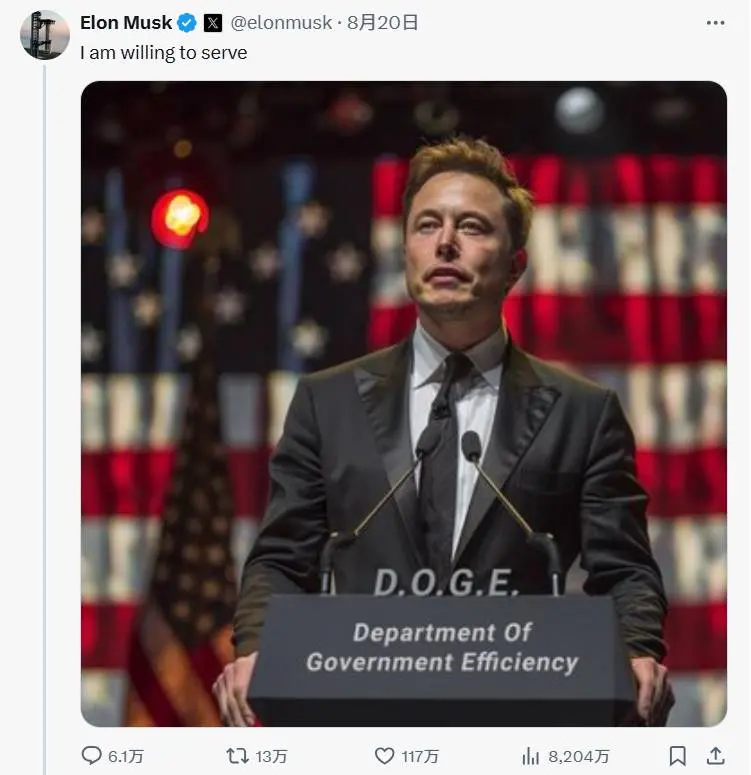Top 10 Funny News in the Crypto World 2024 | Annual Review
Congratulations on the significant improvement of your cognitive dimension this year, completing the transformation from a crypto novice to a crypto consumer.
Author: Nianqing, ChainCatcher
Happy New Year! How do you plan to spend the last moments of 2024?
If you need some NetEase Cloud moments tonight, it might look like this:
In April, you encountered rare heavy rain in the deserts of Dubai;
In September, the A-shares broke through 3300 points, and you quickly cashed out to buy A-shares;
In November, you were afraid of being robbed during Ethereum Devcon in Thailand, so you covered the logo on your T-shirt with white tape;
In December, Bitcoin broke through $100,000, and the news you shared attracted likes from friends and family, who said you must have made a fortune by entering early. You choked back tears and replied: Not much, just a small profit.
……
This year, your cognitive dimension has greatly improved, completing the transformation from a crypto novice to a crypto consumer.
Here is your investment sentiment for 2024:
Year after year, the flowers are similar, and I really want to break even in the crypto world.
On this special occasion, ChainCatcher has summarized some events that highlight the festive atmosphere beyond "financial consumption"------
(This article only represents the author's personal humor. If you have darker, humorous, or satirical news, feel free to discuss with us on X platform and @ChainCatcher_)
Vitalik Becomes the Adoptive Father of Internet Celebrity Hippo Moo Deng
In September this year, a two-month-old pygmy hippo named Moo Deng (Jumping Pig) at the Chonburi Zoo in Thailand quickly became famous due to its playful interactions with its keepers, turning into a well-known internet meme with various meme images created. The hippo craze also swept through the crypto circle, with several chains launching their own memecoins named after it, including Ethereum and Solana.
Interestingly, after receiving the MOODENG airdrop from the deployer, Vitalik sold off the tokens for several days, causing MOODENG to drop over 70% from its peak. However, in November, Vitalik visited the zoo to see little hippo Moo Deng, which led to the Ethereum chain's meme token MOODENG hitting an all-time high.
Recently, Vitalik announced that he has become Moo Deng's adoptive father, stating that over the next two years, he will donate 10 million Thai Baht to help the little hippo grow up healthy and happy, and "maybe I will donate more because I have reserved 88 ETH for Moo Deng and her friends." Following this news, MOODENG surged nearly 70% in 24 hours.
But to put it in perspective, Vitalik received a total of 61.7 billion MOODENG tokens, accounting for 14.68% of the total supply, worth several million dollars.

Solana Officially Releases Breakpoint Advertisement, Satirizing the Current State of Crypto Conferences
On August 1, Solana's official social media released a promotional video titled "Breakpoint: not your average crypto conference." This video satirizes the current state of crypto summits with sharp and incisive commentary. For instance, there are more speakers than attendees, participants collect "a ton" of project merchandise, listeners care more about airdrops and token launches than project innovation, guests often repeat similar viewpoints and force concepts, and discussions often lack coherence. This video was quickly translated into multiple languages, sparking discussions (or self-mockery) within the industry, and has garnered over a million views. Interestingly, Solana Breakpoint indeed delivered on its promise, as the Breakpoint summit held in September received high popularity and acclaim.

Revisit: https://x.com/solana/status/1818718599579943075
On November 5, Solana also released a video titled "Build for users, not VCs," seemingly calling back to the satirical advertisement from August. This latest video lists a series of crypto industry jargon, such as discussing building infrastructure, improving scalability, bridging to mainnets, re-staking, establishing partnerships with well-known protocols, and quickly securing funding, but never inquiring about consumers, users, or specific use cases.
Click here to view: https://x.com/solana/status/1853567281630150859
Bankless Founder and Synthetix Founder Engage in an Offline Real Fight
There are many online brawlers in the crypto community, but few dare to actually fight. On October 11, Synthetix founder Kain Warwick and Bankless founder David Hoffman engaged in an offline real fight in Salt Lake City, Utah.
This match was co-hosted by Permissionless and the fighting live-streaming platform Karate Combat, with Permissionless being a cryptocurrency-themed conference co-hosted by Bankless and Blockworks, offering free tickets to the fighting event for ticket holders.
The reason for their fight stemmed from some disagreements during an online discussion about core issues in DeFi and the crypto industry. They had previously reached a $500,000 betting agreement regarding the sponsorship scale of Synthetix's infinex. This crypto fight attracted significant attention, with Polymarket opening a betting pool on their duel as early as September 24.
The real fight lasted less than ten minutes, with the final result being that Bankless founder David beat Synthetix founder Kain, who was significantly larger than him.

Related article: 《 Crypto Real Fight: Bankless Founder Beats Synthetix Founder 》
A Spa in New York Chooses to Mine Bitcoin to Heat Its Pools Due to High Electricity Costs
On the surface, Bathhouse, located in Brooklyn, New York, is an ordinary public bath. However, behind these warm pools are dozens of Bitcoin mining machines running 24/7.
In 2019, two young men who enjoyed soaking in baths after workouts established the first Bathhouse in Brooklyn, featuring three hot spring pools, two saunas, a steam room, and two Turkish baths. However, the temperature-controlled environment meant high energy consumption, with their monthly electricity bill reaching $20,000. In 2021, after seeing videos online of using Bitcoin mining machines to heat pools, the two decided it was the most meaningful thing in the world and decided to give it a try. By the end of 2021, they purchased 12 Bitcoin mining machines to power the two warm pools at the Williamsburg branch of Bathhouse, generating about 1,200 THz of computing power per second. This year, the Bathhouse branch in New York City's Flatiron District opened, with all four hot spring pools and three Turkish baths heated by 14 larger and better Bitcoin miners at a rate of 2,600 THz per second.
Although the income from Bitcoin mining does offset some costs, the two founders stated they view mining merely as an engineering solution to effectively utilize energy and capital. Compared to the profits from Bitcoin mining itself, this concept and marketing approach have significantly increased their visibility.
Thus, Bathhouse has never sold any Bitcoin and emphasizes that there are no plans to sell in the future; they will store the mined or customer-paid Bitcoin in the company's long-term savings.

After Bitcoin Surpasses $100,000, Financial Times Issues an Apology
On December 5, Bitcoin first broke through the $100,000 mark, and shortly after, the Financial Times published a meme-covered letter titled "Hodlers: an apology: A mea culpa to mark a BTC milestone." In this article, the Financial Times wrote: "Long-time readers of FT Alphaville may have formed the impression that the authors have been skeptical about cryptocurrencies, especially Bitcoin, both in the past and present. This is correct…"
Nevertheless, as Bitcoin's price surpassed $100,000, given our long-standing cynicism, many commentators seemed to think they should apologize, so here it is: If at any point in the past 14 years you chose not to buy this continuously rising asset based on our "evaluation," we sincerely apologize. It's great when your account balance rises. If you misunderstood our crypto cynicism as a declaration of support for tradfi, we apologize for that too, as we dislike it as well.
Many in the crypto community likely began "venting" by sharing the title, but in reality, this article is a self-deprecating or sarcastic "apology," a typical example of British "dark humor."

Related article: 《 Behind the Sarcastic "Apology" is a Cry from News Practitioners 》
Airdrop Competition Escalates, LayerZero Performs "Insulting" Airdrop
The cross-chain interoperability protocol LayerZero officially issued an airdrop worth over $100 million in June this year. Prior to this, LayerZero underwent a month-long witch hunt, believing that the highest quality users should receive airdrop rewards, and these top users should be the most "persistent" ones.
LayerZero has been dubbed the "witch killer" due to its introduction of a new "bounty reporting mechanism," which involves multiple stages of scrutiny, including self-reporting, official review, and bounty reporting, making it a "multi-angle, all-around" anti-witch approach. The large-scale cleansing movement provoked a backlash from many ++airdrop hunters++ ------"2.16 million witch addresses, the largest witch pool ever created, airdrop hunters are electronic beggars, holding bowls to ask for alms, zkSync passes by without even looking." However, more self-deprecating remarks emerged, such as "the military book has twelve volumes, each volume has a name," with many addresses innocently caught in the crossfire, having interacted honestly and spent real money but receiving nothing, leading to the emergence of a new term in the Chinese community: insulting airdrop.

Related article: 《 ++Those++ Targeted by LayerZero's "Witch Hunt": We are the "Tools" Creating False Prosperity on the Blockchain 》
Interestingly, during the airdrop claiming process, LayerZero also invented an airdrop "donation mechanism" (Proof-of-Donation), which simply means "pay to claim airdrop," requiring a donation of $0.10 for each ZRO token. This donation mechanism can essentially be viewed as a kind of "airdrop tax."
Related article: 《 Pay to Claim ZRO, This Airdrop Has Created a New Twist on Pay to Earn 》
Musk Gets His Wish, Finally Becomes Minister of D.O.G.E
In this election year in the United States, Musk has become particularly active in politics. As early as August, Musk mentioned wanting to establish a government efficiency committee during an online discussion with Trump, stating, "I think we need a government efficiency committee to examine where it makes sense to spend money and where it doesn't."
The government department was officially named the "Department of Government Efficiency," abbreviated as D.O.G.E, thanks to the special contribution of the DOGE community!
On November 12, Trump officially announced that Musk and former Republican presidential candidate Vivek Ramaswamy would lead the Department of Government Efficiency, making "D.O.G.E" a reality, and Musk completed his transformation from "Dog King" to "Minister of D.O.G.E."
However, it should be noted that although D.O.G.E and Musk's related Dogecoin $DOGE only differ by a few separators, there is no direct conceptual connection between them.

Sun Yuchen Eats the "Most Expensive Banana in History" Worth $6.2 Million
On November 21, Sun Yuchen purchased Maurizio Cattelan's iconic work Comedian banana for $6.2 million, making it the "most expensive banana in history."
On November 29, Sun Yuchen held a press conference at the Peninsula Hotel in Hong Kong titled "Sun Yuchen Wins the World's Most Expensive Banana: Redefining the Boundaries of Art and Crypto Culture." At the conference, Sun Yuchen ate the $6.2 million banana he won at auction, stating that the banana, as a concept of decentralization, transcends borders and boundaries. He also revealed in an interview that he made the decision to eat the banana right after successfully winning it, wanting to become a part of its history.
Reports indicate that the banana was purchased by a Sotheby's staff member from a fruit stand in Manhattan's Upper East Side that morning. The fruit stand owner, who is from Bangladesh, revealed that the banana was priced at 35 cents. This means the auction price was 14.85 million times the actual value of the banana.
Italian artist Maurizio Cattelan's conceptual art piece "Comedian" aims to explore the value of art, the nature of consumerism, and the absurdity of the art market through an ordinary banana, satirizing market speculation. Before the auction, the BAN Meme coin launched by Sotheby's vice president also successfully generated buzz for this auction event in the crypto circle, with BAN's market cap reaching as high as $378 million. It was this Meme coin that caught Sun Yuchen's attention regarding the banana auction.

Related article: 《 After Buying the Most Expensive Banana, We Spoke with Sun Yuchen 》
HBO Documentary Aims to Reveal Satoshi Nakamoto's True Identity, All Related Parties Deny Involvement
No one wants to be Satoshi Nakamoto, as this identity is too dangerous.
In October, HBO announced that its upcoming documentary "Money Electric: The Bitcoin Mystery" would reveal the true identity of Bitcoin's anonymous creator, Satoshi Nakamoto. The film is directed by Emmy-nominated Cullen Hoback, known for "Q: Into the Storm."
Several well-known figures closely associated with Bitcoin and the cryptocurrency industry, including Craig Wright (who claims to be Satoshi Nakamoto) and Hal Finney (an early Bitcoin developer), have publicly denied any connection to the HBO documentary.
Craig Wright, despite publicly claiming to be Satoshi Nakamoto since 2016, has failed to gain widespread acceptance for his claims over the past few years. He stated on social media recently: "There is still no conclusive evidence regarding Satoshi Nakamoto's identity. Anyone claiming to know the truth is merely speculating." This statement has sparked intense discussions on social media.
On the other hand, the family of the late Hal Finney has also publicly stated that they were not involved in the production of this documentary and do not wish to associate Finney's name with any unverified theories or speculations. They emphasized that Hal Finney's contributions are more reflected in the development and promotion of Bitcoin technology, rather than in debates about Satoshi Nakamoto's identity.
TON Ecosystem Mini Game Hamster Kombat Draws Attention from Iranian Military and Official Opposition
This year, the trend of click-to-earn mini games has swept across the globe. On the streets of Iran, in subway stations, taxis, and buses, you can see people tirelessly clicking on their phone screens. Most of these seemingly leisurely Iranians are users of Hamster Kombat.
According to local media reports on June 24, Iranian government officials and hardliners strongly oppose the blockchain game "Hamster Kombat," claiming it is a tool of Western soft power aimed at distracting the public from the upcoming presidential elections. Amid the deteriorating economic situation and rising inflation in Iran, millions of Iranians view Web3 games as a way to make money. Hamster Kombat is a click game on Telegram where users earn points by performing repetitive tasks and potentially receive airdrops.
Hossein Delirian, spokesperson for the Iranian National Cyber Space Center, stated that using games for cryptocurrency mining has become a breeding ground for hacker crimes, and participants in these games should be cautious about protecting their information and accounts. This controversy has also drawn attention from the religious community, with prominent Shia scholar Ayatollah Nasser Makarem Shirazi describing cryptocurrencies as "the root of many evils" and urging people to avoid playing Bitcoin-related games like Hamster Kombat.
Special Note
In fact, many funny and interesting events in the crypto world this year occurred in the Meme circle, such as:
《 Girlfriend Hair Collection Battle: When Performance Art Meets Meme, Rapidly Reaching a Market Value of Tens of Millions in Two Days 》
《[++When Meme Coins Encounter Social Hotspots: LUIGI Performs "Crypto Version of Robin Hood" Plot](当 Meme 币遇到社会热点:LUIGI 上演\“加密版罗宾汉\”剧情)》
《 How a Kid Who Live-Streamed a Token Scam Became a New Internet Sensation 》
《 ++Meme Perspective Awards: About My Experience of Launching a Meme Coin with a Refrigerator… 》
Memecoins, as a typical example of "attention economy," have taken the combination of the crypto world and performance art to the extreme, with people finding themes, angles, and narratives, provoking people's nerves in absurd, bizarre, and even vulgar ways. However, I personally do not believe this has any direct relation to crypto; they are merely dressed in the guise of token issuance. Therefore, these interesting moments were not specifically considered part of the "crypto world" in this article, but I still believe they are an important part of Crypto culture.
Disclaimer: The content of this article solely reflects the author's opinion and does not represent the platform in any capacity. This article is not intended to serve as a reference for making investment decisions.
You may also like
Hassett: Trump is studying whether "removing Powell" is an option
Strategy returns surpass Nvidia, Tesla, Google, Apple and Microsoft
Polygon and Jio bring blockchain to 450 million users in India

Algorand Foundation and The Core Launch ‘Build on Blockchain’ Series for Industry Leaders

